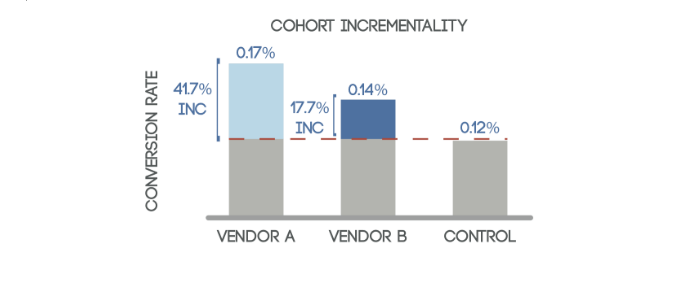What is Incrementality in Marketing?
What Is Incrementality in Marketing?
Incrementality in marketing is the lift or increase in the desired outcome (for example, awareness, web visits, conversions, revenue, profitability) provided by marketing activity.
Incrementality testing and measurement can provide the true incremental contribution of your paid media at the channel, tactic, campaign, or ad set level. Incrementality in marketing is especially needed for channels where ad impressions are difficult to map and measure, such as “walled garden” social channels including Facebook, Snap and Pinterest, or even TV and direct mail.
Why Is Incrementality Measurement Important?
Because they don’t have access to all the data outside their own environment, every digital ad platform uses the same flawed last-touch attribution method. Reports provided by ad platforms will never match up with site-side analytics reports or what’s observed in a brand’s sales data. Taking platform reporting at face value is a risky practice that can lead to bad decisions and lost revenue.
which media investments contribute to business metrics and by how much. Measuring for incrementality identifies where to eliminate waste and surfaces opportunities to scale, expand and reallocate media spend for maximum growth.
With incrementality measurement, you can answer questions like:
- Which media channel, publisher, or campaign is contributing to my desired outcome (leads, LTV, ROAS, revenue, net profit/$, etc.)?
- What happens if I start buying media from a new platform or if I reduce or stop buying ads with a platform?
- Will launching new campaigns or ads increase contribution to conversions at the portfolio level or will it cannibalize from other channels?
How do you measure incrementality of media?
The most accurate way to measure incrementality of media is through testing and experimentation. To measure incrementality, audiences are randomly segmented into test and control groups. The difference in conversion rates between the two groups demonstrates the marginal incremental contribution of that media channel.
Incrementality measurement can vary in complexity from a simple holdout test as described above to multivariate experiments so elaborate they require the expertise of a trained data scientist. But, when carefully designed and cleanly executed, controlled experiments can utilize data from an unlimited number of sources to reveal the incremental impact of just about anything marketers want to test – on any outcome that can be measured.
Incrementality measurement in action
Let’s look at some examples of incrementality in marketing and see how incrementality is calculated
Perhaps a brand wants to better understand the effectiveness of its retargeting campaign. To calculate the incrementality, they would withhold a small but statistically significant group of their audience (typically 10%) and not serve them the retargeting ads. Out of this group, which did not see the retargeting ads, 10% end up repurchasing the products.
The test group did receive the ads, and they repurchased 13% of the time. Using these numbers, we can use the incrementality formula to calculate incrementality.
The incrementality formula: (%CR Test – %CR Control) / %CR Test
So in our example, the incremental lift is 3%, which based on the formula, results in a 23% incrementality.
Incrementality Case Study: Soft Surroundings
Soft Surroundings, a women’s clothing retailer, chose to work with Measured to better understand and optimize their retargeting efforts.
Measured’s retargeting experiment revealed that the incremental cost per acquisition CPA(i) was well above CPA targets and what was reported by the vendors. The company’s largest retargeting vendor by spend was heavily over-indexed and serving ads beyond a recommended frequency cap.
As a result of these findings, retargeting budgets were reduced by 52% in the next few months. The extra budget was shifted to higher-performing prospecting tactics like Facebook. Topline revenue improved 17% MoM while yearly sales comps increased 12%.
The Impact of Incrementality Measurement in Marketing
Incrementality in marketing allows you to see which audiences should be served which ads and on what platforms.
Other methods of measurement, such as media mix modeling (MMM) and multi-touch attribution (MTA), cannot measure views or impressions, so you’re essentially just measuring clicks. Incrementality measurement accounts for the impressions and clicks within each of the platforms under test to give marketers a more accurate view of the true contribution of their media across the entire portfolio.
Read our guide all about incrementality management!
Video: Leveraging Incrementality to Value Retargeting vs. Prospecting
Only Measured delivers ongoing, reliable insights based on scientifically sound experiment designs that incorporate your source of truth transaction data. Everything is automated – ingestion and management of data from hundreds of sources, experiment design and implementation, and continuous reporting for confident, agile decision-making.
Want to learn more? Get a Demo


